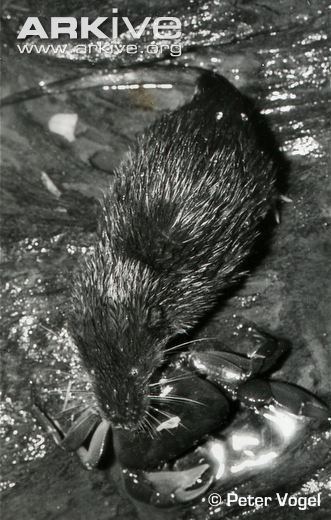Order Afrosoricida | Phylum Chordata Family Tenrecidae Scientific name Micropotamogale lamottei Rank Species | |
 | ||
Similar Ruwenzori otter shrew, Giant otter shrew, Mammal, Potamogalinae, Tenrec | ||
The Nimba otter shrew (Micropotamogale lamottei) is a dwarf otter shrew and belongs to the mammal family Tenrecidae. Tenrecs have been found throughout mainland Africa and Madagascar; however, its subfamily Potamogalinae are the shrew-like creatures found in sub-Saharan Africa. This species belongs to the genus Micropotamogale, literally meaning "dwarf shrew". It is native to the Mount Nimba area which rests along the border of Liberia, Guinea, and Côte d’Ivoire (Ivory Coast) in West Africa.
Contents
Description
The Nimba otter shrew is a small bodied mammal. Weighing only about 125 grams (4.5 ounces) it has a body length of 6-9 inches(15–22 cm.) with 1/4 to 1/3 of its body size being its tail. It has been described as a "miniature sea otter with a rat tail". Its pelage is long, hiding its ears and eyes, and almost always universally colored (usually brown, but black and gray otter shrews have been spotted).
Evolution and Life History
The Nimba otter shrew is solely classified as a member of Tenrecidae, with African hedgehogs and rodents, based on morphological structures. New breakthroughs in genetic testing are finding that it does belong in this family and subfamily Potamogalinae. Unfortunately, due to heavy mining operations for iron ore in the Mount Nimba area, the fossil record is all but destroyed. It is also difficult for scientists to gain access because the mountain crosses the borders of three different countries.
Ecology and behavior
The Nimba otter shrew is nocturnal and semiaquatic. It resides in soft soils around creek beds and streams. It is a solitary creature and has only been seen with other shrews during mating seasons and when a mother is nursing newly born young. The breeding pattern of the Nimba otter shrew is also unknown, but believed to be polygamous; as there have been no witnessed accounts of breeding in the wild and the Nimba otter shrew has not mated in captivity.
Conservation status
The IUCN had listed the Nimba otter shrew as endangered in 1990, but in 2016 the status was changed to near threatened. The species is confined to an area less than 5,000 square km on Mount Nimba, which is currently fragmented due to mining and wetland rice agriculture. The mining operations also produce runoff into the creeks and streambeds that is highly toxic. The current population is decreasing at a rate of 1 per 10 square km (almost 500 otter shrews per year). Although an exact number is unknown at this time, there is believed to be less than several hundred in captivity and 2500-3500 in the wild. At this rate the Nimba otter shrew will be extinct between 2017 and 2020.
